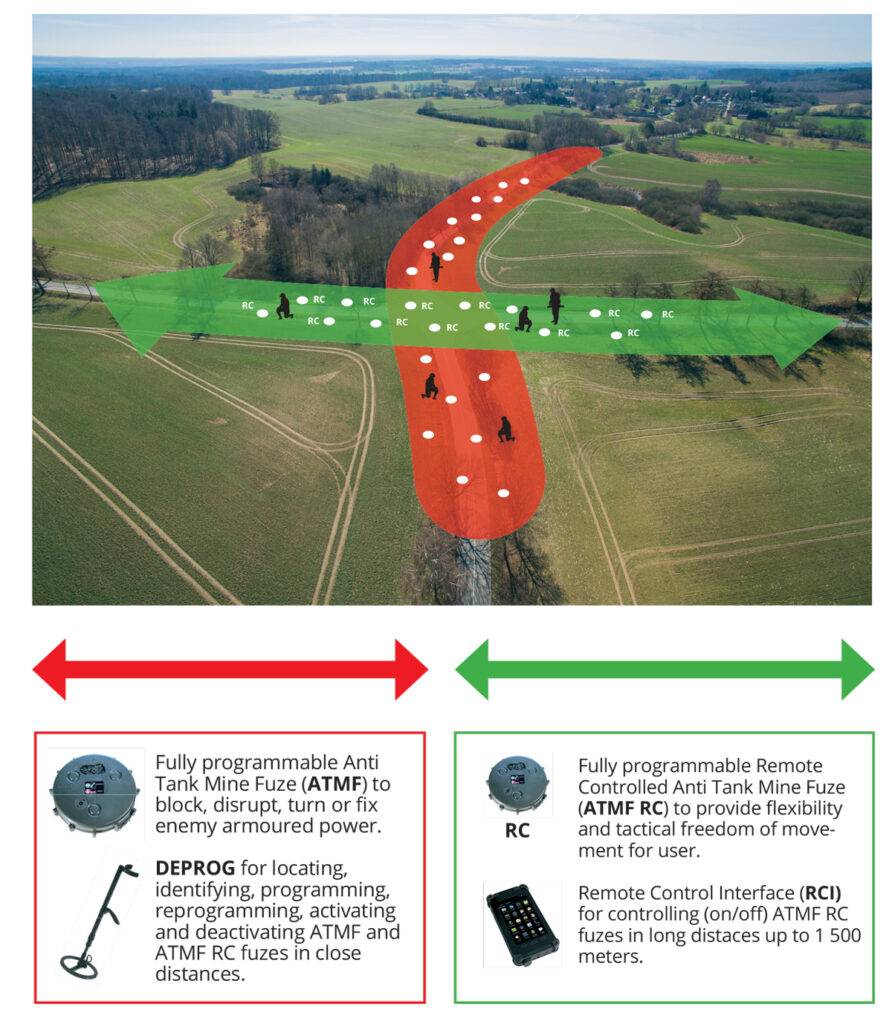Mines are traditionally viewed as defensive weapons designed to deny access to certain areas, slow down advancing forces, or protect strategic positions. However, in modern warfare, the use of mines has evolved. They have also been employed offensively to disrupt enemy movements, launch surprise attacks, and create chaos in adversary ranks.
Mines have always been more than just defensive weapons. In a pre-explosive warfare era, the Roman troops knew how to themselves by scattering a spiked, simple trap called a caltrop or crow’s foot, to prevent the enemy from crossing, for example, a shallow river. Traps similar to landmines, but without explosives, have been used widely, for example, as late as the Vietnam War. The Viet Cong dug pit traps for American soldiers, with sharp bamboo sticks smeared with feces at the bottom.
The use of actual mines in warfare dates to ancient times when rudimentary explosive devices were employed to disrupt enemy forces. In 1277 AD, the Chinese military employed explosive mines against Mongol invaders. Described in historical texts like the Huolongjing, these mines were among the earliest recorded uses of gunpowder in military engineering, designed to detonate when triggered by pressure or a tripwire. In the 18th Century, early landmine-related explosive devices were used in European warfare. During the Napoleonic Wars, when an explosive named fougasse was used. It was typically a hole filled with gunpowder and shrapnel, designed to be ignited when enemy forces approached.
Mines Became Standard Tools in World Wars
The modern concept of mine warfare began in the 19th and 20th centuries, particularly during the two World Wars when landmines and naval mines became standard defence tools. The primary purpose of these mines was to protect territories, create barriers, and prevent enemy advances. Mines have also been used as offensive weapons for as long as they be dropped from airplanes or fired close to enemy positions with artillery.
During World War II, mines were extensively used in both land and naval warfare. For example, the Germans employed millions of mines along the Atlantic Wall, a defensive fortification along the coast of Europe, to prevent Allied invasions. Mines were also used in North Africa and Eastern Europe to defend key positions and slow enemy advances.
In the post-war era, the use of mines continued in various conflicts, including the Korean War, the Vietnam War, and numerous regional conflicts. During these wars, mines were primarily used for defence, although their use in offensive operations began to emerge.
In naval warfare, the use of mines has been particularly offensive, such as the mining of British harbors and sea routes in 1940 by the Germans, or the mining of the Gulf of Finland between Tallinn and Leningrad in 1941 by the Finns and Germans.
Offensive Mine Warfare: A Paradigm Shift
In modern military strategy, the concept of using mines as an offensive weapon has gained traction. This shift is driven by several factors, including technological advancements, changes in warfare tactics, and the need for more versatile and asymmetric methods of warfare. The greatest effect of mines is achieved when used in combination with other weapons. A threat has no power if it is not monitored.
One way to use mine is to act like a terrorist – as happened in the Cambodia and the Mozambique civil wars – scattering them indiscriminately, for example, rendering fields unsuitable for farming. In an organized approach, the use of mines must always be supervised and done in conjunction with other weapons systems. Otherwise, mines are ineffective and can even harm one’s own troops. In principle, Western armies always make a mine map. If the focus of the battles shifts quickly, clearing the mines is easy. But if, during retreat or attack, one must fire mines using artillery or airforce, their exact locations may not be recorded. As a weapon, mines are thus directive: they can be used to force the enemy to act in a certain way, such as advancing through a narrow, mine-cleared area.
Mines can be deployed offensively to disrupt enemy supply lines, communication routes, and reinforcement efforts. By planting mines in key logistical routes, an attacking force can create significant delays and logistical challenges for the enemy, thereby weakening their ability to respond effectively.
In the Vietnam War, the Viet Cong used improvised explosive devices (IEDs), a form of mine, to target U.S. convoys and supply routes. These IEDs were strategically placed to maximize disruption and cause significant damage to enemy forces.
Tools of Psychological Warfare
The use of mines offensively can also serve as a psychological weapon. The mere presence of mines can create fear and uncertainty among enemy forces, leading to hesitation, delays, and a loss of morale. This psychological impact can be as effective as the physical damage caused by the mines.
In Afghanistan, Taliban forces have used mines and IEDs to create a constant threat to coalition forces. The fear of mines has forced these forces to adopt more cautious and slower movements, impacting their overall operational effectiveness.
Mines can be used offensively to shape the battlefield in favor of the attacking force. By deploying mines in certain areas, an attacker can channel enemy forces into specific zones where they are more vulnerable to attack. This tactic is particularly effective in guerrilla warfare, where the goal is to control the movement of a larger, more conventional force. During the Soviet-Afghan War, Mujahideen fighters used mines to control Soviet troop movements, forcing them into ambushes and other prepared kill zones. This use of mines as an offensive tool was a key factor in the success of the Mujahideen’s asymmetric warfare tactics.
Offensive Surprise and Ambush
Mines can be used offensively in ambush scenarios to catch enemy forces off guard. When combined with direct attacks, mines can increase the lethality of an ambush by preventing enemy forces from retreating or maneuvering out of the kill zone.
In the Iraq War, insurgents often used mines and IEDs in conjunction with small arms fire to create deadly ambushes against U.S. and coalition forces. The combination of explosive devices and gunfire maximized the impact of these attacks.
Distinguish Between Combatants and Non-combatants
While mines can be used effectively in offensive operations, their use raises significant challenges and ethical concerns.
One of the primary concerns with the use of mines, especially in an offensive role, is their indiscriminate nature. Mines cannot distinguish between combatants and non-combatants, leading to a high risk of civilian casualties. This has led to international efforts to ban or restrict the use of certain types of mines, such as anti-personnel mines, under agreements like the Ottawa Treaty.
Mines, particularly when used offensively in civilian areas, can have a long-term impact on the local population. Mines that are not cleared can remain active for decades, posing a continuous threat to civilians and hindering post-conflict recovery and development.
In Cambodia, the extensive use of mines during the Vietnam War and subsequent conflicts has left the country with one of the highest rates of landmine casualties in the world. The long-term impact on the country’s economy and development has been severe.
The use of mines in an offensive capacity must also consider international laws governing armed conflict. The use of mines must comply with the principles of distinction and proportionality, ensuring that military objectives are balanced against the potential harm to civilians and civilian infrastructure.
Smart and Networked Mines
The future of offensive mine warfare will likely be shaped by technological innovations that address some of the challenges associated with traditional mines.
One example is smart mines, which are designed to reduce the risks associated with traditional mines by incorporating sensors and remote-control capabilities. These mines can be activated or deactivated as needed, reducing the risk to civilians after a conflict has ended.
Modern smart mines can be programmed to deactivate after a certain period or can be triggered only by specific types of targets, reducing the likelihood of unintended casualties.
Advances in communications and sensor technology have led to the development of networked mine systems. These systems allow mines to be linked together, sharing data and coordinating their detonation for maximum effect. This can be particularly effective in offensive operations where coordination and timing are critical.
A networked minefield could detect an approaching enemy column and trigger a coordinated explosion to maximize damage.
As the use of mines evolves, so too do the technologies designed to counter them. Advances in counter-mine technologies, such as mine detection drones and autonomous mine clearance systems, will play a crucial role in mitigating the risks posed by offensive mine warfare.

Types of Mines Used Offensively
Various types of mines can be employed in offensive operations, each with specific characteristics and tactical uses.
- 1. Anti-Tank Mines
Anti-tank mines are designed to disable or destroy enemy armored vehicles. When used offensively, these mines can be placed along expected routes of enemy armor, in choke points, or in areas where vehicles are likely to be concentrated. During the Gulf War, Iraqi forces used anti-tank mines to protect strategic locations and to ambush advancing coalition armored units. - 2. Anti-Personnel Mines
Anti-personnel mines are intended to injure or kill enemy infantry. When used offensively, these mines can be deployed in areas where enemy troops are likely to move, such as trails, roads, or in and around defensive positions. The use of anti-personnel mines in the conflict in Bosnia during the 1990s was widespread, with mines often laid in areas to terrorize civilian populations and prevent the movement of enemy forces. One purpose to use anti-personnel mines is to prevent or slow down the disarming of other mines and traps. - 3. Naval Mines
Naval mines are used to disrupt enemy naval operations. When used offensively, they can be deployed in shipping lanes, harbor entrances, or other strategic maritime areas to damage or sink enemy ships and disrupt maritime logistics. During the Korean War, U.S. forces used naval mines to block North Korean ports and disrupt the supply of war materials to the front lines. - 4. Improvised Explosive Devices (IEDs)
IEDs are a type of mine that can be used in various forms, from roadside bombs to hidden devices in vehicles or buildings. They are particularly effective in asymmetric warfare, where they are used offensively to target occupying forces or disrupt enemy operations. IEDs have been a primary weapon used by insurgents in Iraq and Afghanistan, causing significant casualties and disrupting military operations.



